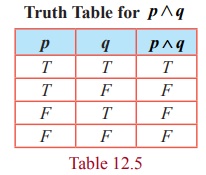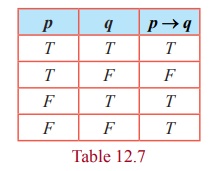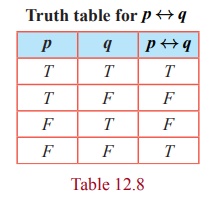Discrete Mathematics | Mathematics - Mathematical Logic: Logical Connectives and their Truth Tables | 12th Maths : UNIT 12 : Discrete Mathematics
Chapter: 12th Maths : UNIT 12 : Discrete Mathematics
Mathematical Logic: Logical Connectives and their Truth Tables
Logical
Connectives and their Truth Tables
(1) Truth Table for
NOT [¬] (Negation)
Truth Table for ¬ p

(2) Truth table for
AND [ ∧ ] (Conjunction)
Truth Table for p Λ q

(3) The truth tables
for OR [ ∨ ] (Disjunction)
Truth Table for p ∨ q

Example 12.12
Write
the statements in words corresponding to ¬ p, p
∧ q
, p ∨ q
and q ∨ ¬p, where p is ‘It is cold’ and q
is ‘It is raining.’
Solution
(i) ¬p :
It is not cold.
(ii) p ∧ q : It is cold and raining.
(iii) p ∨ q : It is cold or raining.
(iv) q ∨ ¬p : It is
raining or it is not cold
Observe
that the statement formula ¬p has only 1 variable p and its truth table has 2 =
(
21 ) rows. Each of the statement formulae p ∧ q and p ∨ q has two variables p and q . The truth table
corresponding to each of them has 4 = ( 22 )
rows. In general, it follows that if a statement formula involves n variables, then its truth table will
contain 2n rows.
Example 12.13
How many
rows are needed for following statement formulae?
(i) p ∨ ¬t ∧ ( p
∨ ¬s ) (ii) ( ( p
∧ q
)
∨ ( ¬r ∨ ¬s )) ∧ ( ¬t ∧ v)
Solution
(i) ( p ∨ ¬t ) ∧ ( p ∨ ¬s ) contains 3 variables p, s ,and t . Hence the corresponding truth
table will contain 23 = 8 rows.
(ii) (
( p ∧ q)
∨ ( ¬ r
∨ ¬ s
))
∧ ( ¬ t
∧ v)
contains 6 variables p, q, r,
s,t
, and v . Hence the corresponding
truth table will contain 26 = 64 rows.
Conditional Statement
Definition 12.13
The conditional statement of any two statements p and
q is the statement, “If p , then q ” and it is denoted by p → q . Here p is called the hypothesis or
antecedent
and q is
called the conclusion or consequence. p → q is false only if p is true and q is false. Otherwise it is true.
Truth table for p → q

Example 12.14
Consider
p → q
: If today is Monday, then 4 + 4 = 8.
Here the
component statements p and q are given by,
p: Today is Monday; q:
4 + 4 = 8.
The
truth value of p →
q is T because the conclusion q
is T.
An
important point is that p →
q should not be treated by actually
considering the meanings of p and q in English. Also it is not necessary
that p should be related to q at all.
Consequences
From the
conditional statement p →
q , three more conditional
statements are derived. They are listed below.
(i) Converse statement
q → p .
(ii) Inverse statement
¬ p →¬q .
(iii) Contrapositive
statement ¬ q →¬p .
Example 12.15
Write
down the (i) conditional statement (ii) converse statement (iii) inverse
statement, and (iv) contrapositive statement for the two statements p and q given below.
p :
The number of primes is infinite. q:
Ooty is in Kerala.
Solution
Then the
four types of conditional statements corresponding to p and q are respectively
listed below.
(i) p → q : (conditional statement) “If the number of primes is infinite then Ooty
is in Kerala”.
(ii) q → p : (converse statement) “If Ooty is in Kerala then the number of primes is infinite”
(iii) ¬ p →¬q (inverse statement) “If the
number of primes is not infinite then Ooty
is not in
Kerala”.
(iv) ¬ q →¬p (contrapositive statement) “If Ooty
is not in
Kerala then the
number of primes is not
infinite”.
Bi-conditional Statement
Definition 12.14
The bi-conditional
statement of
any two statements p and q is the statement “ p if and only if q ” and is denoted by p ↔ q .
Its truth value is T , whenever both p and q have the same truth values, otherwise it is false.
Truth table for p ↔ q

Exclusive OR (EOR)[ ⊽ ]
Definition 12.15
Let p and q be any two statements. Then p EOR q is such a compound statement that its truth value is
decided by either p or q but not both. It is denoted by p
⊽ q . The truth value
of p ⊽ q is T whenever either p or
q is T, otherwise it is F. The truth table of p ⊽ q is given below.

Example 12.16
Construct
the truth table for ( p
⊽ q)
∧ ( p
⊽ ¬q)
.

Also the
above result can be proved without using truth tables. This proof will be
provided after studying the logical equivalence.
Related Topics